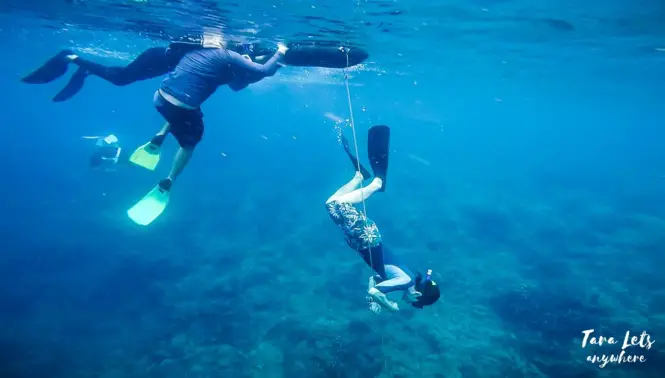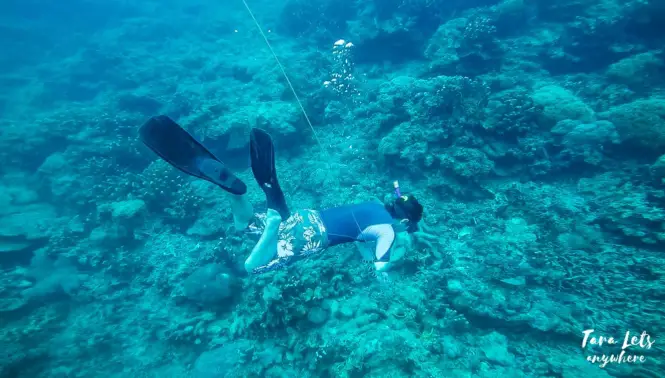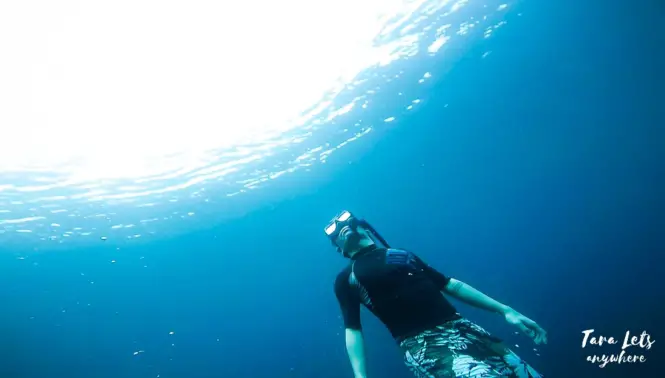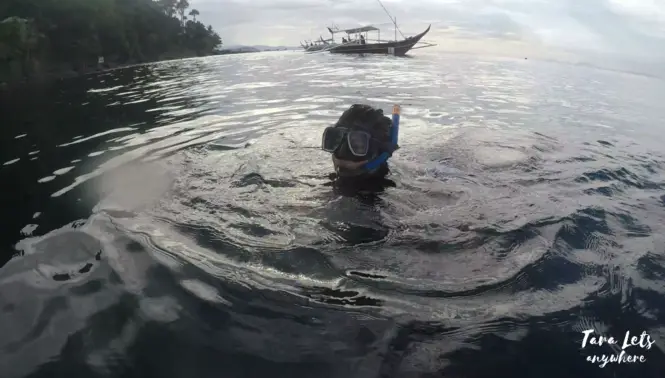
Freediving Lesson in Batangas (A Non-Swimmer’s Experience)
I didn’t know how to swim. There, I said it. My travel friends will beg to disagree, and sometimes I even describe myself as a decent swimmer. However, even though I can float and swim from end to end, if there’s any slight disturbance in the water or something unexpected happens (e.g., Hali leaves me alone in the open water), I panic and sink.
Last November, my friend Peng invited me to take a 2-day course on introduction to freediving.
Peng was a non-swimmer and he can now thread and freedive. He took this course and practiced a few times afterwards to get it right. The change is fascinating, considering that when we traveled together, I remember him staying in the boat to sleep rather than joining us in the water. Now he says plain swimming is boring, and snorkeling & freediving is the way to go.
Our instructor is Coach Rogelio and he holds lessons in Batangas. The course costs P2200 per person, including rental equipment. I went here with Hali, who surprisingly wanted to come even though he’s a decent swimmer and freediver already (in my opinion anyway). I wanted to take the course just so I can say that I tried, and Hali wanted to learn how to stay longer underwater.
Contents
2-Day Basic Freediving Course
Accdg to Coach Rogelio, 80% of Filipinos are non-swimmers. This figure includes indigenous groups that live in sea communities but do not follow basic protocols when it comes to freediving, causing damage to their health especially to the eardrums.
When I signed up on this basic freediving course, what worried me is not drowning or dying — it’s not being able to improve at all. I didn’t think about the time I drowned in a pool and almost dragged my sister with me or when I panicked while snorkeling in El Nido and Hali couldn’t get to me because I was flailing and kicking. Instead I thought about my failed grades in high school PE because I couldn’t even serve a ball in table tennis. I’m not a sports person. I know that it might sound funny to some people, but we have different fears.
Meanwhile, Hali was pretty chill because that’s who he is.
We stayed in Mabini, Batangas. Coach’s headquarters is next to the beach, so after discussion we can go down to the sea to practice.
1st Day: Survival Floating and Basic Freediving Skills
On our first day, we had a short discussion about freediving including do’s and don’ts, survival floating, equalization (popping the ears) using valsalva and how to fit and wear a snorkel.
I can’t emphasize how much we learned here. Even the info on basic use of snorkel is very useful. In the past, whenever I snorkeled, I would waste so much time in the water re-fitting the snorkel and taking it off/on to remove fog or water that had seeped in. After learning these, afterwards I was able to snorkel much more smoothly.
After the lesson, we then went to the shore. The strategy is to start at shallow water first and, once the instructor sees that the students are comfortable, practice is moved to deep waters.
We started with survival floating first, which is a life-saving skill to have because it lets you float when you’re tired or having cramps. Apparently, I’d been doing survival floating already. Once when we were island hopping in Guimaras, Hali told me to swim afar so he could record me swimming back for a travel video we were making. I was already in a spot far away but then he got preoccupied with fixing the pole for this GoPro — I had a minor panic knowing no one was watching me and had no choice but to float back to the boat. I’m telling you, knowing this will literally save your life.
Our first exercise is called “down the line”, where we have to go underwater, one by one, while holding onto a rope and then equalizing once we reached certain depths. The goal is to reach the end of the rope, but of course everyone has their own pace and while we were encouraged, we were not forced or pressured to do more than what we were comfortable with.
Hali of course did great, while I only reached 1 meter depth because I couldn’t equalize. Actually, I didn’t want to go deeper. I felt the pressure in my head and thought, “Nope.” I repeated this shallow-dive-resurface a few times.



The second exercise is “duck dive.” It’s a basic skill in freediving which allows you to dive underneath cleanly, quietly and smoothly.



Hali has been freediving for as long as I could remember, but he said learning this helped him tremendously. His challenge was holding his breath althroughout, as he has the tendency to breathe out by producing bubbles while resurfacing. Don’t ask me how I did — I tried to dive and then immediately resurfaced so that I looked like a curved ball. It’s cute actually, but apparently I’m the only one who thinks that.

The best thing for me about our first-day lesson is that I gained more confidence in the water and snorkeled on my own back to the shore. I had snorkeled alone and without vests only once and even then I didn’t stray too far from land, so this is a good improvement.
2nd Day: Rescue Training
On our second day, we were taught basic rescue training. Hali and I confirmed what we’d suspected all along — you should not approach a panicked swimmer. Anyway, Coach Rogelio taught us how to do it properly so we can get the person back to safety.
We went to a different beach to practice. Hali was able to do all the exercises, while I sunk when it was my turn to save him.

Later that afternoon, we had a fun dive where we can practice all the things we’d learned and Coach would stand by, watch and tell us his observations on what we can improve on. (Most importantly, he captures our attempts in his Gopro.) By the end of it, Hali has almost perfected his down the line and duck dive. Meanwhile, I contented myself by practicing threading and snorkeling. I didn’t do any more practice with freediving since I realized I’m not really interested in it, and I would just like to be self-capable of swimming especially when I am traveling to places alone.
How we did after the course
Again, we’d learned so much about swimming and freediving during the 2-day basic freediving course. Non-swimmers and even people who’d been swimming/freediving confidently can learn a thing or two to improve their skills.
After the course, we’d learn essential knowledge about buying and using snorkeling equipment, survival and rescue. Hali has better skills in freediving that he’d like to practice more of. I wasn’t disappointed that I didn’t do better in freediving because I did learn how to thread and snorkel and I became a little used to open water without wearing a lifevest.
Things I learned
Additionally, here are a few things that I’d learned in the course.
1. First, you must be willing to learn.
This isn’t like elementary or high school where you’re forced to learn and pass the exams. You do this in your own will. This means diving underwater even though you’re unsure or scared because you want to conquer your fears.
Most people start out afraid, but it’s their willingness to try and learn that gives them the push to just do it.
2. Second, it takes practice and more practice!
The freediving lesson is just the beginning. My friend Peng says he still wasn’t good at it after taking the lesson, but he practiced afterwards. Now he can swim and freedive confidently. (Also, he’s training to be a freediver coach himself!) Hali and I also plan to do this.
3. Lastly, it helps to be with friends.
I feel more comfortable that Hali and Peng were there with me. I’d probably have been more nervous if I were with strangers.
In addition, Peng has personally recommended our instructor so I feel confident that he can rescue us when necessary.
Where to book the freediving lesson
You can contact Coach Rogelio in the FB page of Shadow Freedivers. The basic freediving course is open even for non-swimmers.
There are 1-day and 2-day courses for basic freediving. I suggest taking the 2-day course because not only will you be learning about rescue and emergency situations, you will also get more water time for practice.
Shadow Freedivers holds lessons in either Batangas or Puerto Galera. We went to Mabini, Batangas (near Camp Netanya). This is the preferred location because it’s closer to Manila and they have cats. If you need more information like how to get to location, where to stay, so and so, you can contact your instructor directly.
Tip: If you’re going to take the lessons in Batangas, make sure to eat at Balanay View and taste their seafood lomi!

Our budget is about P3550 per person. Here are the estimates:
- 2-day freediving lesson – P2200
- Transport from Manila to Batangas (round-trip) – P500
- Food – P500
- Homestay – P350
We think P2200 is very sulit, and we’d willing to pay more considering how useful the course is. Transport, food and accommodation are at your personal expense.
Thanks Coach Rogelio for a fun weekend! Also for providing us copies of your Gopro videos. 🙂 Also, thanks to Peng for introducing and encouraging me to take this course. Let’s snorkel on our next trips!
Can you swim or freedive? Have you taken a basic freediving course? Tell us in the comments below!
What to read next:
Are you into snorkeling and freediving? Check out these places:
- Pagkilatan (Batangas)
- Apo Reef (Mindoro)
- Apo Island (Negros Oriental)
- Moalboal (Cebu)
- Best snorkeling spots in Southeast Asia

Katherine Cortes is a long-time backpacker and a freelance writer/editor. She likes beaches, snorkeling trips, and relaxing staycations (preferably with bath tubs!).



9 Comments
orlando dofajar/ Sophia Fajardo
We would like to thank you Especially Coach Roger
Ran,Wet and Jr.all them they friendly, passionate, Committed…
Jessica Miranda
Hi can i know if you have their contact details? Although am only 24 but i dont use facebook.
Katherine Cortes
Hi, you can contact Coach Roger of Shadow Freedivers – 09278659443
Bryan
Hi,
Thanks for sharing so much information on free diving. We will definitely try this with Shadow Freedivers. However, we only have one question though, are the coaches certified? Are they also giving certification lessons?
THanks.
Katherine Cortes
I’m not sure if they give certification lessons but they can certainly point you where to get one.
Jemi Lee
Hi, I am so happy I came across your blog post. We want to try booking this with Shadow Freedivers. Just some questions. Can you share the logistics of this trip? Transportation and accommodation, if you can. Thanks!
Katherine Cortes
Hi Jemi! Regarding transport and accomm, ask niyo na lang sa magiging coach niyo kasi yung Shadow Freedivers iba-iba sila ng venue depende sa date. Yung sa’min sa Mabini near Camp Netanya but afaik they also hold courses in other parts of Batangas. Anyway if you inquire with them sasabihin naman nila paano yung transport and accommodation options.
Jeff
Hi, I know this is a relatively old post but I just wanted to ask a quick question. How accommodating are they when it comes to non-swimmers?
I’m interested in learning how to freedive, but, embarrassingly enough, I absolutely cannot swim (as in, I don’t know how to tread water) and I was wondering if they also teach people some of the basics as well.
Katherine Cortes
This is not an old post lol. I published it just a few months ago.
Anyway, if you read it you’ll know I was a non-swimmer too. I can tread a little but only on calm surfaces like lagoons, definitely not in the open sea. Our coach is really good and he gauges first whether the students can go in the deep water; you’re not forced to do anything. I learned to tread and swim here (read the post) and my bf got better at freediving (he’s already a good swimmer but novice at freediving at that time).
If you’re going to schedule a lesson, pls say Hi to Coach Roger for me!